
The Hostage Rescue Attempt In Iran, April 24-25, 1980
The Iran hostage crisis began November 4, 1979,
when a mob of
Iranians seized the U.S. embassy in Tehran,
taking a large group of employees
hostage.
Eleven months earlier, a revolution led by the
Islamic fundamentalist
Ayatollah Ruholla Khomeini
had overthrown Mohammad Reza Pahlavi, the shah of
Iran.
Nineteen hostages were released within a few weeks;
the
remaining fifty-two were held for 444 days.
When it became clear that the
Iranian government
was not going to resolve the problem.
President Jimmy Carter
moved to freeze Iranian assets,
both in the United States and abroad.
Diplomatic
efforts were launched through the United Nations
and various private
intermediaries, but by March 1980 it had
become clear that none of the rival
political groups in Iran
was willing to risk the unpopularity of letting the
hostages go.
This impasse led Carter to order a rescue effort by helicopter,
but
three of the eight helicopters failed before reaching Tehran,
and the mission
had to be aborted. Eight men died in the operation.
President Ronald Reagan defeated Jimmy Carter in November,
1980.
During
that time a new Iranian government had been formed,
and serious
negotiations began soon after, with Algeria as mediator.
The United States
agreed to unfreeze most Iranian assets in
exchange for the hostages.
Finally, on
January 20, 1981 -
only a few hours after Carter left office -
all fifty-two
hostages were released and
landed safely in West Germany.
Overtaking the Embassy
The Iranian revolution may have started in
September of 1978.
Iranians were quite upset at the Shah and took to the
streets.
'Students' from the universities marched and the people took
to the
streets with them.
It cannot be denied that the Shah killed thousands of people
during his reign.
The
actions of the Mullahs were even worse than the Shah's.
The Mullahs have
murdered more than the Shah did,
and that number was greater than 50,000 in the
first year
of the Ayatollah Khomenie's reign alone,
with some people totaling
the deaths at greater than 1 million as of 2003.
The Mullah's did this for
religious reasons, too, not just because of threats of overthrow.
Also, almost 9000
Iranian Army personnel were killed
by the Ayatollah Khomeini in his first year
alone.
On
September 8, 1978, the students of Iran had been holding protests
at their
universities for some time, but this day, the Shah sent in troops
to stop the
riots and killed hundreds of students.
This day became known as 'Black Friday'
in Iran.

When
the Shah left Iran, he was pretty much ignored by the rest of the world.
In
fact, most countries refused to have anything to do with him.
Egypt's Anwar
Sadat allowed the Shah to live there for a short time.
It is after the Shah left
Iran, that Khomeni returned.

Ayatollah
Khomeni returned from exile in France
where the Shah had banished him.
He was a
national hero to the Iranians.
November 4, 1979
'Students'
of Iran,
stormed the American Embassy in Tehran,
seizing Americans at gunpoint
and holding them as prisoners,
or to be technically correct, Hostages,
held for
a political purpose,
and that purpose was to unite Iran as a nation,
and to
humiliate the United States.

The
Ayatollah knew all that was happening.
Students who lead and mostly organized
the
uprising brought back information to the Ayatollah Khomeini.

The
American Embassy was a large complex,
with many buildings. Here are some photos
of the Embassy itself.
This is the Embassy wall, and some graffiti written on
the wall.
The English says, "We will make America face a severe
defeat"
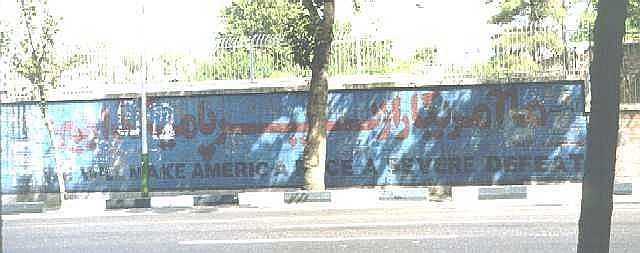


Among the many phrases chanted by the Iranian mobs was the
phrase:
DEATH TO AMERICA

They demanded that U.S. return deposed Shah Mohammad Reza
Pahlavi,
who has been admitted to U.S. for medical treatment.
The U.N. Security Council called on the Iranian militants to free all American
hostages.
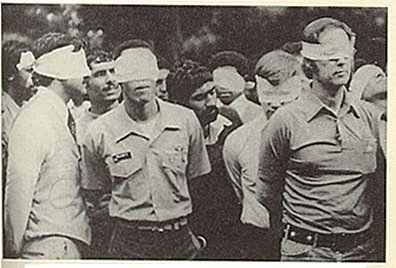
Americans held as hostages illegally by Iranians in Tehran.
These Americans were not the ones who might
have been
connected to SAVAK, the Shah's secret Army,
nor were they anyone the Iranians
had to fear,
they were just embassy personnel, and Marines,
who traditionally
guarded American Embassies.
Iranian
Criminals called on the death of Americans
if force was used to retaliate
against Iran.
This criminal's name was Abdi.
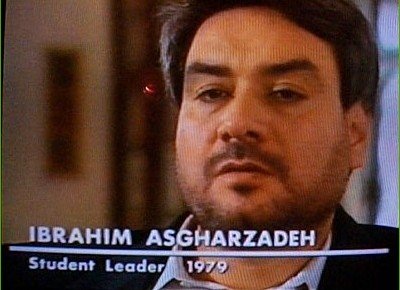
This man, Ibrahim Asgharzadeh is one of the student leaders
| Some personal
accounts:
444 Days: The Hostages Remember Sgt. William Quarles
(marine security guard, |
Victor Tomseth (chief
political officer): That day was a double anniversary. I think it was the anniversary of the day that Khomeini had gone off into exile in Turkey back in 1964, and also the first anniversary of a major riot in Tehran during which people had been killed at Tehran University. So there was a demonstration scheduled for that day. We had our staff meeting the first thing in the morning, and I remember the main debate was whether we should lower our flag to half-mast in recognition of the anniversary on which these three our four people had been killed at Tehran University. It was decided that we would not lower the flag. John Graves (public affairs officer): I happened to be at the window of the press office where I could actually see the gate, the main gate. I don't know quite how it opened; normally there's a big chain around it. But all of a sudden the gates opened and the first flood of students came in. They were mostly women carrying signs like: "Don't be afraid. We just want to set in." Set, not sit. No sign of weapons or anything like that. It didn't look at all serious. Joe Hall (warrant officer, at the chancery): We had a radio in our office so we could hear what the marines and security officers were saying to one another. That way we could keep up with what the hell was going on. "Bulldog" was the code name for the security officer, Al Golancinski. Suddenly I heard on the radio, "Bulldog, someone's cut the chain on the gate and there are two or three Iranians inside. The Iranians got into the basement real quick. At the time, I was in the defense attaché office on the main floor, and we were wondering what the hell to do with our classified stuff. We'd actually been pulling documents out of the files in order to destroy them, when the word came through that the militants had managed to get into the basement. Everybody was immediately ordered upstairs to the second floor. We hought, well shit, we can't carry our classified stuff with us. If the militants did get through, we'd meet them in the hallway with our hands full. So Colonel Schaefer said, "Let's lock it up." We put all the classified documents in the safes and spun the dials. Malcolm Kalp (economics officer, at the chancery): Gradually everybody filtered upstairs. We cleaned out the basement . . . and the first floor, and got everybody up there--the Americans as well as the Iranian workers. Everybody sat along the walls on either side of the hall. The marines came around and started giving out gas masks. Bill Belk (communications officer, at the chancery): The Iranians swarmed in. One guy looked at me and said, "Walk out the door." So I walked out the door. Two guys grabbed me, one on either side, put my hands behind my back, and tied my hands. They had a long nylon rope that they used to tie us up. After my hands were tied, this guy tried to cut the rope with a knife. The rope slipped and he gouged me, stabbed me in the back. They blindfolded me, and I didn't know what to do. I'd never experienced a blindfold before. I thought maybe they were going to take us out and shoot us. I just didn't know what to expect. Col. Charles Scott
(chief of the Defense Liaison Office, |



Photo above are Iranians in America protesting
against the
Shah and the United States!
Ayatollah Ruhollah Khomeini denounced the United States
as the
“Great Satan”. Khomeini encouraged partisans
to seize the U.S. embassy
culminating in the Iranian hostage crisis.
He also help start a war with
neighboring Iraq which
lasted eight years. He ruled Iran until his death in 1989
.
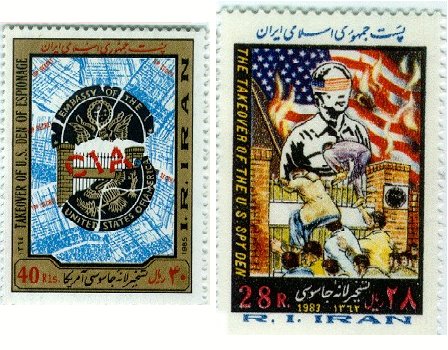
They actually made stamps of what they did.
The hostages were moved around and separated.
They spent many
of the 444 days that they were held hostage
in the embassy compound and in an
Iranian jail.
Some of them were tortured and threatened in an attempt
to get
information and thirteen Americans, mostly women and blacks,
were allowed to
return to the United States.
The conditions in which the hostages were kept were
miserable.
Khomeini had total control of Iran and the hostages.
In
response, Carter froze Iran’s multi-billion dollar assets in America,
further
damaging relations. However, he stated in a press conference,
“I am not going
to take any military action that would cause bloodshed...
We’re going to be
very moderate, very cautious...” (444 Days).
And that seemed to be his policy
for the first few months.
Carter had planned the Mission to happen this way:
Six aircraft and eight helicopters were to fly from the USS
Nimitz i
n the Arabian Sea, and land on an airfield in Southern Iran.
From there
the helicopters would fly into a stadium adjacent
to the United States Embassy
compound and troops would force
an entry into the embassy, rescue the hostages
and return to the USS Nimitz.
Unfortunately, two of the helicopters were lost
due to technical
failures in the first leg of the mission.
This left the bare
minimum of helicopters needed to rescue all the hostages.
When a terrible
accident resulted in the destruction of another helicopter
and a cargo plane and
the death of eight officers, Carter aborted the mission.
Due to all of this the
negotiations were slowed further.
Helicopters
from the USS Nimitz took off from the flight deck on April 24, 1980,
with hopes
to rendezvous with Air Force C-130's at a location known
as Desert One. From
there, they were to re-fuel, then fly to a second
site known as Desert 2. After
an short stay there, they were to assault
the American Embassy, and re-capture
the hostages.
RH-53s being pre-flighted aboard USS Nimitz before launching on the mission
where they would be stymied by dust clouds and various systems failures.
Eagle
Claw was aborted when three helicopters could not complete the mission.
Eight
men died during the aborted attempt to
rescue American hostages held
captive in Iran.
Five of them were airmen from the
8th Special
Operations Squadron at Hurlburt Field, Fla.
They were Marine helicopter
crewmen.
“Take
solace in the fact that what they did only a few could even
attempt,”
said Lt. Gen. Norton Schwartz,
the commander of Alaskan
Command,
at a 20th anniversary commemorative ceremony
at Hurlburt Field,
Fla.
“What they did was keep the promise. They had the guts to try.”

This
is the Memorial Marker for the Brave Men
that gave their lives in service to
their country on April 25, 1980,
during what has become known as the Hostage
Rescue Attempt
dedicated to those men that died, and to those men that
served
with them in trying to rescue those Americans held illegally
by the
Iranian Government for 444 days.
Let us remember these names always.
These men
gave their lives trying to free good men and women.
They did not die in vain.
Three of these men were United States Marines:
Sgt. John D.
Harvey, 21
Cpl. George N. Holmes, 22
SSgt. Dewey L. Johnson, 31
all who died
in or trying to escape their RH-53 Sea Stallion helicopter.
5 of them were members of the United States Air
Force:
Maj.
Richard F. Bakke, 33
Maj. Harold L. Lewis, 35
TSgt. Joel C. Mayo, 34
Capt.
Lyn D. McIntosh, 33
Capt. Charles T. McMillan, 28,
who died in the cockpit
of their C-130 Hercules transport.
When President Reagan was elected, the negotiations
began
to speed up in the period after the election and as Reagan’s
inauguration neared,
so did a conclusion to the crisis. The final agreement was
that the
US had to “lift the US economic sanctions against Iran as well as
to
return $12 billion in Iranian assets frozen in US banks in return for the
hostages”
Ayatollah set the release date for January 20 1981, the day of
Reagan’s inauguration.
As soon as Reagan was sworn in, the hostages were
set free and flew t
o Wiesbaden, West Germany, and then home to America.
The total of
Hostages:
Sixty-six Americans were taken captive when Iranian militants
seized the U.S. Embassy in Tehran on Nov. 4, 1979,
including three who were at
the Iranian Foreign Ministry.
Six more Americans escaped. Of the 66 who were
taken hostage,
13 were released on Nov. 19 and 20, 1979; one was released
on
July 11, 1980, and the remaining 52 were released on Jan. 20, 1981

The
Hostages Finally Arrive Home in the United States!
"Hostages Reveal Iran Torture"
"The emancipated hostages told of beatings and other atrocities
at the
hands of the Iranian captors today
as they telephoned their loved ones back
home.
"One said ... he was told by Iranian interrogators ...
that his mother had
died. He didn't learn that she was still alive
until the freed captives reached
Germany this morning.
"As they began a stay of several days at a U.S. military hospital
in
Wiesbaden, Germany, most of the 52 hostages talked
with their families for the
first time in 445 days. ...
"Col. Leland Holland, 53, security chief of the U.S. Embassy in Tehran ...
'
spent a month in what he called the
"dungeon" and said his captors were S.O.B.s,'
said the colonel's
mother.
'He said his house was ransacked and
everything taken, including his watch and rings.
They took all the furniture and
clothes.'
"A spokesman for the family (of Duane 'Sam' Gillette) said:
'His treatment
was at times disgusting. I think President
Reagan was polite when he termed the Iranians barbarians.
We know that his
letters were covering up what the real
situation was. There was no physical torture,
but there was psychological
pressure.
The food wasn't good and the
conditions were very poor.'
"And the family of Malcolm Kalp said ... '
He told us he was beaten by them
and placed in
solitary confinement because of his escape attempts.'
He served
from 150 to 170 days in solitary. ...
"Returnee David Roeder, 40, of Washington, D.C., said,
'I've never been so
proud to be an American in all my life.' ...
"Outside the hospital ... the crowd ... broke into a chant of
'U.S.A.,
U.S.A.' Only 12 hours and nine minutes earlier,
the two women and 50 men
hostages flew out of Iran on
an Algerian jet to the Islamic Revolutionary
Guards'
jeers of 'Down with America' and 'Down with Reagan.' ... "
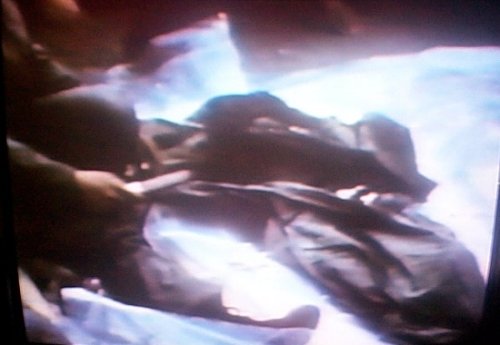
This
is a photo of what the Iranians did to the dead Americans
who took part in the
rescue attempt.
This is a shot of an Iranian man taking his knife to one of the
bodies.
He eventually took off the head of the dead American.
This is a barbaric
act, but it is not as crude as the next photo,
taken of someone who is supposed
to represent the religion of Islam.
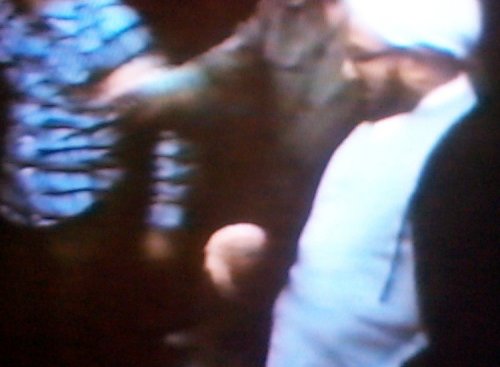
This
is a photo of someone who was supposed to be a holy man in Islam.
His name is
Ayatollah Kalkali. He literally spit on the bodies of our
Marines and Airmen
that died in Desert One in the attempt.
I consider him a criminal, too.
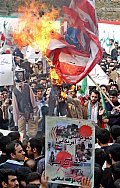
Iranians burn a U.S. flag outside of the former U.S. Embassy
in a gathering marking the 25th anniversary of the seizure
of the U.S. Embassy
in Tehran, on Wednesday, Nov. 3, 2004.
Thousands of Iranian students gathered
outside the former
American embassy in Tehran on Wednesday to mark the
25th
anniversary of the 1979 storming which led to the
year-long "hostage
crisis" between Iran and the United States.
Today, reflecting on their
experiences through the prism of 9-11,
the war in Iraq and two decades of
tumultuous relations with the
Middle East, many say the United States was
too
late to recognize that a new era had begun.
"The day they took us
is the day they should have started
the war on terrorism," said Rodney
"Rocky" Sickmann, 47,
of St. Louis County, Mo., an embassy security
guard.
"Given
the terrorist modus operandi nowadays, we probably
wouldn't come out alive. They
weren't as bold then.
They had a latent fear of the United States," said
Chuck Scott, 72,
of Jonesboro, Ga., a former Green Beret in Vietnam who
was an
Army colonel when he was taken hostage.
Fifty-two of the hostages
were held for the entire 444 days.
Of those, 11 have since died.
Among the rest, memories of
that time have resurfaced
with the kidnappings and beheadings of Americans in
Iraq.
"When I saw them there
blindfolded with the guys with
the ski masks on I had gone through those things
in Iran,"
said Rick Kupke, 57, of Rensselaer, Ind.
"I can tell exactly
what they felt and the fear that's going through them."
William Blackburn Royer Jr.,
73, of Katy, Texas,
remembers being jolted awake by the screams of his captors,
"herded like cattle" into another room, stripped naked and
forced up
against a wall in front of a firing squad.
"The whole thing was a
shock to the system my legs were
shaking from the insecurity of the
situation," he said.
"It was intended as a good psychological
upheaval."
Paul Needham
said he remembers reciting the 23rd Psalm
as he was lined up for a firing squad.
He said he reflects on his captivity every day.
As for the
anniversary......
many
said they prefer to remember another day.
"We celebrate Jan. 20,
the anniversary of our release,"
Laingen said.
"That's a good day.
Nov. 4 is the day the roof fell in."


Tom Flynn, owner of Hillcrest Memorial Park,
was convinced that this
period in American history
was too important to forget and determined to find
a
way to help Hermitage and the nation remember.
With the help of unemployed steel workers in
the
Valley and flags donated by the families of veterans
buried at Hillcrest,
Flynn decided to erect an American
flag for each day the hostages had been held.
On day 100, the first 100 flags were flown. In a special
ceremony that evening,
Mr. and Mrs. Matrinko of Oliphant,
Pennsylvania (near Scranton) raised the 100th
flag and
lighted a flame of freedom for their son, Michael, who was
still being
held a captive. The flame would burn until
Michael was able to come home and
extinguish it. Flynn
further committed to add a flag to the memorial for each
day the hostages were held. Little did he know that this
commitment would mean
344 additional flags.
Special ceremonies at Hillcrest were held on day 200, 300, 365, and 400,
as
time in captivity began to be marked by the number of flags flying on
the
Avenue. Included in these special tributes was a 52-hour prayer vigil,
one hour
for each of the remaining hostages still being held.
When eight American servicemen lost their lives
during an ill-fated rescue
attempt in Iran, the citizens of Scranton joined
forces to dedicate a permanent
monument in memory of these brave men and placed
it in the Avenue of Flags.
Over 1,000 flags were used to keep the flags flying during the original 444
days,
as the flags needed to be replaced three to four time a year. All but 100
of these
original flags were donated by supporters from all around the world.
Most of them had once draped the casket of an American veteran. The flags
represented periods in history from the Spanish-American War through the
Vietnam
conflict. One Canadian flag also flies on the Avenue in recognition of
the
Canadian embassy's help in saving six hostages from captivity and eventually
returning them to freedom.
On days when the sound of these 444 symbols of American pride can be heard
flapping in the wind from a distance, visitors are filled with a sense of pride
and
remembrance of a time when America was held hostage, and many have been
seen
to leave the park with tears filling their eyes.
I
pray we never forget the lives that were lost
and gave their all in the Hostage Rescue Attempt.
Wild Thing
Just one last
thing...... years ago President Reagan said this.........
"I don't think you can overstate the importance
that the rise of Islamic fundamentalism
will have to the rest of the world in the
century ahead-especially if, as seems possible,
its most fanatical elements get their
hands on nuclear and chemical weapons
and the means to deliver them
against their enemies." --Ronald Reagan